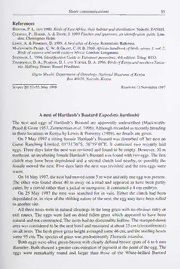Table Of ContentShortcommunications 55
References
Britton,p.L. (ed) 1980.BirdsofEastAfrica,theirhabitatanddistribution.Nairobi:EANHS.
Clement,P., Harris,A. & Davis,J. 1993Finchesandsparrows, an identification guide. Lon-
don: ChristopherHelm.
Lewis,A. &Pomeroy,D. 1989.AbirdatlasofKenya.Rotterdam: Balkema.
Mackworth-Praed,C.W.&Grant,C.H.B. 1960.Africanhandbookofbirds,series 1,vol.2,
BirdsofeasternandnortheasternAfiica.London: Longmans.
SvENSsoN,L. 1994.IdentificationGuidetoEuropeanpasserines,4thedition.Tring: BTO.
Zimmerman,D.A.,Pearson,D.J.andTurner,D.A. 1996.BirdsofKenyaandnorthernTanza-
nia. HalfwayHouse: RusselFriedman.
OgetoMwebi,DepartmentofOsteology,NationalMuseumsofKenya,
Box40658,Nairobi,Kenya
Scopus20: 53-55,May 1998 Received 13November 1997
A nest ofHartlaub's BustardEupodotis hartlaubii
The nest and eggs of Hartlaub's Bustard are apparently undescribed (Mackworth-
Praed&Grant 1957,Zimmermanetal. 1996).Althoughrecordedasrecentlybreeding
inthree locations inKenyaby Lewis & Pomeroy (1989), nodetails are given.
On 7 May 1997 a sitting female Hartlaub's Bustard was disturbed offhernest on
Game Ranching Limited, 01°3r36''S, 36°59'48''E. It contained two recently laid
eggs. Three days laterthe nest was revisited and found to be empty. However, 30 m
northeast,anincubatingfemaleHartlaub'sBustardwasfoundwithtwoeggs.Thefirst
clutch may have been depredated and a second clutch laid nearby, or possibly the
female moved the nest. Five days laterthe nest was revisited and the two eggs were
warm.
On 16May 1997,thenesthadmovedsome5mwestandonlyoneeggwaspresent.
The other was found about 40 m away on a road and appeared to have been partly
eaten,by acorvidratherthan ajackal ormongoose. Itcontaineda4~cm embryo.
On 25 May 1997 the nest was searched for in vain. Either the clutch had been
depredatedor, inview ofthe shiftingnatureofthenest,theeggmayhavebeenrolled
to anothersite.
All three nests were innatural clearings inthe long grass withnoobvious entry or
exit routes. The eggs were laid on dried fallen grass which appeared to have been
natural andnotconstructed. Thenestshadnodiscemablehollow. The stamped-down
areawasconsideredtobethenestbowlandmeasuredatabout23 cm(circumference)
onallnests.Thefreshgreengrassheightaveragedsome46cm,andtheseedingheads
some 95 cm. The species ofgrass waspredominantly Themeda triandra.
mm
Both eggs were olive green-brown with clearly defined brown spots of4 to 6
diameter. Both showedagreaterconcentrationofpigmentatthepointoftheegg.The
eggs were remarkably round and larger than those of the White-bellied Bustard
56 Shortcommunications
Eupodotissenegalensis. Measurements ofthetwoHartlaub'sBustardeggswere51 x
mm
58and52x60 (thesecondeggwasfractured,sothelengthisanestimate,accurate
to within about 2 mm). Two White-bellied Bustard eggs laid in December 1996 on
GameRanchingLtdwere42x53.5 and43x52.5mm.White-belliedBustardeggsare
similarlycolouredbutthebrownspotsarediffuseandevenlydistributed.Theyarethe
size and shapeofachicken's egg with aratherpronouncedpoint.
Acknowledgements
IamgratefultoColinJacksonandDrLeonBennunoftheOrnithologyDepartment,NationalMuse-
umsofKenyafortheircomments.IalsowishtothankDrDavidHopcraftforgivingmepermissionto
liveandworkonhisranch.
References
Lewis,A. &Pomeroy,D. 1989.AbirdatlasofKenya.Rotterdam: Balkema.
Mackworth-Praed,C.W. &Grant,C.H.B. 1957.Africanhandbookofbirds, Series 1,vol 1.
BirdsofeasternandnortheasternAfrica.London:Longman.
Zimmerman,D.A.,Turner,D.A.&Pearson,D.J. 1996.BirdsofKenyaandnorthernTanzania.
HalfwayHouse:RusselFriedman.
SimonThomsett,OrnithologyDepartment,NationalMuseumsofKenya,Box40658,Nairobi,
andThePeregrineFund,566WestFlyingHawkLane,Boise,Idaho83709, USA
Scopus20:55-56,May 1998 Received 17October 1997,revised20November 1997
Sighting ofWhite-collared KingfisherHalcyon chloris
in south-central Somalia
Duringarecentvisittothecoastalplainsnorth-eastofMogadishuIobservedasingle
specimenofWhite-collaredKingfisherHalcyon chloris.
While examining shallow wells used by pastoralists at a point a few kilometres
north ofWarsheikh, and only 400-600 m from the shoreline, I noticed a strikingly
marked, greenish blue and whitebird on the top ofa low bush, at adistance ofabout
30m. The type ofbird andplumage details were clearon examinationthough 8x10
—
binoculars itwas amedium-sizedkingfisherwith a shiny greenish-blue mantle and
head(downtothroughtheeye),clearwhitebelowandaroundtheneck(thelastfeature
wasquitestriking).LaterreferencetovanPerlo(1996)andFryetal. (1988)confirmed
the identification.
I estimate the location was 46°E, 2°30'N. This would be in Somalia atlas square
64AasdefinedbyAsh&Miskell (1983),whomentiontworecords,"oneoldandone
recent", from the north ofSomalia. They make no reference to any records from the
south-centralregion. Fryetal. (1988) includethe sametworecordsbutalso statethat
"other records from the south are probably erroneous". This reference is to Snow
(1978),whomentionstworecords,oneprobablybeingintheareaofBalad,60-70km
due westofthe siteofthepresentrecord.

